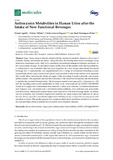Mostrar el registro sencillo del ítem
Anthocyanin metabolites in human urine after the intake of new functional beverages
| dc.creator | Agulló, Vicente | es_ES |
| dc.creator | Villaño Valencia, Débora | es_ES |
| dc.creator | García-Viguera, Cristina | es_ES |
| dc.creator | Domínguez-Perles, Raúl | es_ES |
| dc.date.accessioned | 2024-03-20T16:38:54Z | |
| dc.date.available | 2024-03-20T16:38:54Z | |
| dc.date.issued | 2020 | |
| dc.identifier.citation | Agulló, V., Villaño, D., García-Viguera, C., Domínguez-Perles, R. (2020) Anthocyanin metabolites in human urine after the intake of new functional beverages. Molecules, 25(2), 1-16. https://doi.org/10.3390/molecules25020371. | en |
| dc.identifier.issn | 1420-3049 | |
| dc.identifier.uri | https://hdl.handle.net/2454/47745 | |
| dc.description.abstract | Sugar intake abuse is directly related with the increase of metabolic diseases such as type 2 diabetes, obesity, and insulin resistance. Along this line, the development of new beverages using alternative sweeteners could help with combatting the pathophysiological disorders associated to the consumption of sugar. To provide evidence on this issue, in the present work, the bioavailability of anthocyanins was evaluated after the acute ingestion of a new maqui-citrus-based functional beverage rich in polyphenols, and supplemented with a range of sweeteners including sucrose (natural high caloric), stevia (natural non-caloric), and sucralose (artificial non-caloric), as an approach that would allow reducing the intake of sugars while providing bioactive phenolic compounds (anthocyanins). This approach allowed the evaluation of the maximum absorption and the diversity of metabolites excreted through urine. The beverages created were ingested by volunteers (n = 20) and the resulting anthocyanin metabolites in their urine were analyzed by UHPLC-ESI-MS/MS. A total of 29 degradation metabolites were detected: Caffeic acid, catechol, 3,4-dihidroxifenilacetic acid, hippuric acid, trans-ferulic acid, 2,4,6-trihydroxybenzaldehyde, trans-isoferulic acid, and vanillic acid derivatives, where peak concentrations were attained at 3.5 h after beverage intake. Sucralose was the sweetener that provided a higher bioavailability for most compounds, followed by stevia. Sucrose did not provide a remarkably higher bioavailability of any compounds in comparison with sucralose or stevia. The results propose two sweetener alternatives (sucralose and stevia) to sucrose, an overused high calorie sweetener that promotes some metabolic diseases. | en |
| dc.description.sponsorship | This research was funded by the Spanish MINECO, grant number AGL2016-75332-C2-1-R and AGL-2016-75332-C2-2-R. VA was funded by a FPI grant (BES-2017-079754) of the Spanish MINECO. The APC was funded by the projects AGL2016-75332-C2-1-R. | en |
| dc.format.mimetype | application/pdf | en |
| dc.language.iso | eng | en |
| dc.publisher | MDPI | en |
| dc.relation.ispartof | Molecules 2020, 25(2), 371 | en |
| dc.rights | © 2020 by the authors. Licensee MDPI, Basel, Switzerland. This article is an open access article distributed under the terms and conditions of the Creative Commons Attribution (CC BY) license. | en |
| dc.rights.uri | http://creativecommons.org/licenses/by/4.0/ | |
| dc.subject | Dietary intervention | en |
| dc.subject | Maqui | en |
| dc.subject | Juice | en |
| dc.subject | Anthocyanins | en |
| dc.subject | Bioavailability | en |
| dc.subject | UHPLC-ESI-QqQ-MS/MS | en |
| dc.title | Anthocyanin metabolites in human urine after the intake of new functional beverages | en |
| dc.type | Artículo / Artikulua | es |
| dc.type | info:eu-repo/semantics/article | en |
| dc.date.updated | 2024-03-20T16:26:23Z | |
| dc.contributor.department | Agronomía, Biotecnología y Alimentación | es_ES |
| dc.contributor.department | Agronomia, Bioteknologia eta Elikadura | eu |
| dc.contributor.department | Institute on Innovation and Sustainable Development in Food Chain - ISFOOD | en |
| dc.rights.accessRights | Acceso abierto / Sarbide irekia | es |
| dc.rights.accessRights | info:eu-repo/semantics/openAccess | en |
| dc.identifier.doi | 10.3390/molecules25020371 | |
| dc.relation.projectID | info:eu-repo/grantAgreement/MINECO//AGL2016-75332-C2-1-R | en |
| dc.relation.projectID | info:eu-repo/grantAgreement/MINECO//AGL2016-75332-C2-2-R | en |
| dc.relation.publisherversion | https://doi.org/10.3390/molecules25020371 | |
| dc.type.version | Versión publicada / Argitaratu den bertsioa | es |
| dc.type.version | info:eu-repo/semantics/publishedVersion | en |



